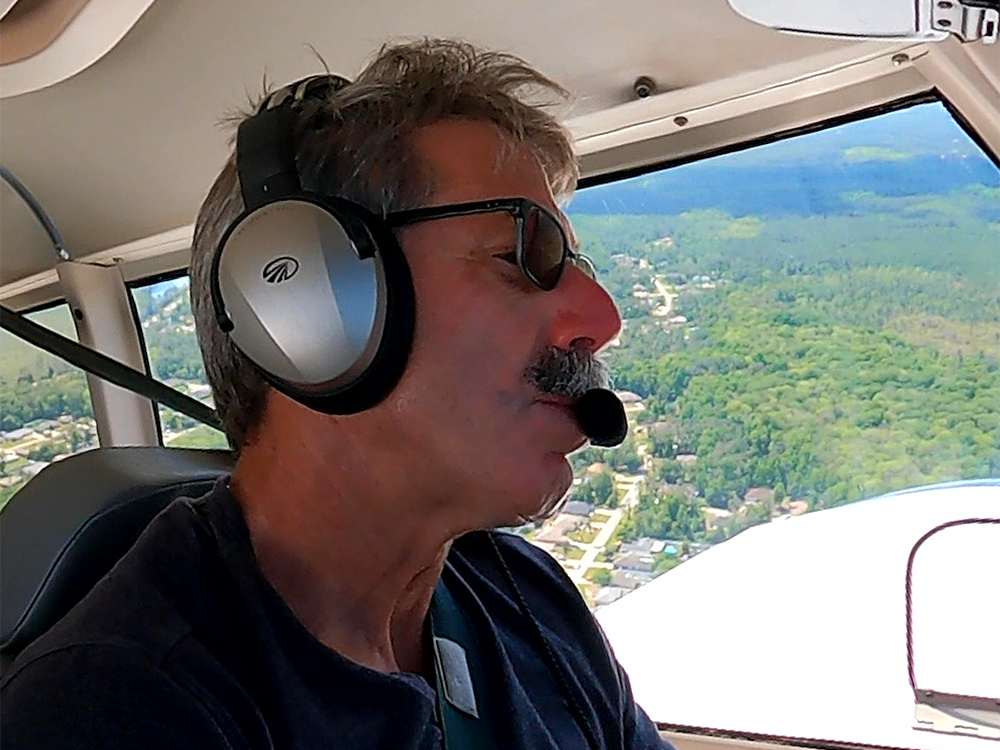
Les Abend was faced with the go-or-no-go decision on two very different occasions. [Screengrab from FLYING YouTube video]
I had myriad reasons why my Piper Arrow hadn’t slipped the surly bonds in weeks, so when the day’s weather transformed into a beautiful Florida clear-and-a-million sky, I had no excuses. The mission was uncomplicated. I’d fly to an airport only 15 minutes away, top off the tanks, and return home while practicing a GPS approach or two.
After a methodical engine run-up, and a “not-everybody-gets-to-do-this” grin on my face, I pushed the throttle forward on all 200 horses of the IO-360. A scan of the JPI and analog gauges indicated we were go for launch. As the runway lights and centerline markings started to blur with normal acceleration, I noticed that both the Aspen Avionics flight display and the analog airspeed were indicating 35 knots. Approximating the distance traveled on the 5,500-foot runway, I quickly realized that the airspeed should be higher. Ruh-roh.
For whatever reason, the Aspen groundspeed wasn’t supplying information to assist in clarifying the issue. So, do I abort? Plenty of concrete was in front of the nose, but that’s not how my airline-pilot brain is wired. Aborted takeoffs terminate in blown tires, fires, and a trailblazing trip through unforgiving dirt.
Instead of stopping, I applied gentle back pressure to the yoke. The airplane leaped into the air. That abrupt reaction answered the question of a flyable airplane. Both airspeed indications seemed stuck at 73 knots no matter how I adjusted the pitch attitude. I was being lied to. A groundspeed accelerating through 100 knots confirmed the assessment.
Surely, the problem was a dead bug in the pitot tube that will work its way out. But nope. Nada. It was time for a return to terra firma. In my best airline-pilot voice, I requested an entry to the downwind leg. The tower controller replied with nonchalant approval. In the next moment, the Aspen rewarded with me a display of red Xs. As I would later determine, the older Aspen system reacts to erroneous airspeed by eliminating display of all parameters. Great. I smiled at the clear blue sky. Single-engine IFR would have been slightly challenging, but that’s why the backup analog displays remain installed.
Having finally developed a visceral feel for the Arrow’s flight characteristics, and the fact that groundspeed was available on the Garmin GNS 430, activating the panic button was not a consideration. Gas. Undercarriage. Mixture. Prop. The airplane was safely on the ground with minimal angst. I taxied off the runway with a sense of having cheated fate, aiming straight for my friends at the maintenance hangar. The problem had to be something simple.
Josh Jackson greeted me on the ramp with a shrug and a curious smile. After conveying the not-so-harrowing experience, he proceeded directly to the pitot tube, removing it from the bottom of the wing. We noticed the remnants of what appeared to be a very small portion of a bug carcass. Perhaps the culprit had been discovered. A gentle blow through the hose line produced an appropriate airspeed indication on the analog gauge. Josh and I agreed that a test flight was in order. With no logical reason, I remained skeptical that we had found the problem.
While Josh tasked himself with reconnecting the pitot tube, I pondered the age-old question of aborting or not aborting.
When operating a 775,000-pound jet, as in my former life, or a jet of almost any size, the takeoff decision process is critical. For many years, airline operating procedures allowed for a wide range of captain’s discretion as to the reasons for discontinuing a takeoff. Even though V1 was the ultimate decision speed, rejected takeoffs were occurring well after. Multiple blown tires that dramatically reduced braking effectiveness, thrust reversers ingesting foreign-object damage into the engines, powerplant fires, and severe airframe damage with injuries and fatalities were potential results.
What the Data Said
After a focused study of rejected takeoff incidents and accidents, it was determined that if the majority of problems causing the abort decision had been taken airborne, the continuation of the flight would have resulted in a successful outcome rather than a catastrophic event. Airline philosophy began to evolve such that the calculated V1 speed for the specific runway was considered as the point in the takeoff roll when the decision to abort should have already been in progress.
Additionally, airlines refined the reasons to reject a takeoff below V1. For most carriers, an aborted takeoff above 80 ktas is considered a high-speed event and a situation that may require specific checklist procedures, brake inspections, and reverse-thrust inspections depending upon the speed attained. The implications are that a rejection after 80 ktas, but before V1, would be better handled on the ground. A good example would be an engine fire. That being said, most jets have systems and procedures to tackle an in-flight engine fire, even during takeoff. It’s a simulation that is practiced during almost every recurrent training cycle.
Part of my pre-retirement before-takeoff briefing dissertation was that, after 80 ktas and before V1, we would abort for only an engine failure, an engine fire, a wind-shear warning, or if we were absolutely certain that the airplane was not capable of flying. An erroneous airspeed indication did not fall into that category because we had other sources for speed information that used separate pitot-static systems, notwithstanding very accurate groundspeed readings.
Testing the Theory
So, as I taxied the Arrow out to the runway for the “test flight,” I contemplated a rejected-takeoff decision. Armed with the possibility that an erroneous airspeed situation may again be part of my future—almost as if being spring loaded like a recurrent training session during my airline life—I decided that the best course of action would be to make the decision early in the takeoff roll. I sighted a centerline marking a couple thousand feet past the beginning of the runway that would leave me a leisurely opportunity to pull the throttle to idle and allow the airplane to roll with virtually no braking before departing the hard surface into the dirt.
Well, lo and behold, it took no longer than a thousand feet for the decision to be made. Neither the Aspen nor the analog airspeed gauge displayed anything, let alone an erroneous indication. Proud that a couple gallons of fuel and a couple microns of brake pads had been saved, I taxied back to the maintenance hangar.
What was the culprit? A dried and cracked pitot-tube hose end that was attached via a barbed T-connection behind the sidewall bulkhead in the cockpit. One side of the “T” was routed to the analog airspeed indicator, and the other side was routed to the Aspen. Though Josh was confident that snipping off a small piece of the cracked end of the hose would solve the problem, it was an indication that it was time to replace all the hoses, which involved removing a fuel tank…which soon led to a lower checkbook balance.
To go or not to go? That can sometimes be the question. And it’s not always an easy decision, but it’s one that should be made prior to the takeoff roll.

Sign-up for newsletters & special offers!
Get the latest FLYING stories & special offers delivered directly to your inbox






